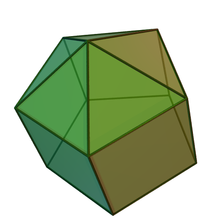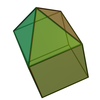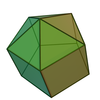Elongated pyramid
Polyhedron formed by capping a prism with a pyramid
| Elongated pyramid | |
|---|---|
 Example: pentagonal form | |
| Faces | n triangles n squares 1 n-gon |
| Edges | 4n |
| Vertices | 2n + 1 |
| Symmetry group | Cnv, [n], (*nn) |
| Rotation group | Cn, [n]+, (nn) |
| Dual polyhedron | self-dual |
| Properties | convex |
In geometry, the elongated pyramids are an infinite set of polyhedra, constructed by adjoining an n-gonal pyramid to an n-gonal prism. Along with the set of pyramids, these figures are topologically self-dual.
There are three elongated pyramids that are Johnson solids:
- Elongated triangular pyramid (J7),
- Elongated square pyramid (J8), and
- Elongated pentagonal pyramid (J9).
Higher forms can be constructed with isosceles triangles.
Forms
| name | faces | |
|---|---|---|
 | elongated triangular pyramid (J7) | 3+1 triangles, 3 squares |
 | elongated square pyramid (J8) | 4 triangles, 4+1 squares |
 | elongated pentagonal pyramid (J9) | 5 triangles, 5 squares, 1 pentagon |
See also
- Gyroelongated bipyramid
- Elongated bipyramid
- Gyroelongated pyramid
- Diminished trapezohedron
References
- Norman W. Johnson, "Convex Solids with Regular Faces", Canadian Journal of Mathematics, 18, 1966, pages 169–200. Contains the original enumeration of the 92 solids and the conjecture that there are no others.
- Victor A. Zalgaller (1969). Convex Polyhedra with Regular Faces. Consultants Bureau. No ISBN. The first proof that there are only 92 Johnson solids.
- v
- t
- e
Convex polyhedra
- triakis tetrahedron
- rhombic dodecahedron
- triakis octahedron
- tetrakis hexahedron
- deltoidal icositetrahedron
- disdyakis dodecahedron
- pentagonal icositetrahedron
- rhombic triacontahedron
- triakis icosahedron
- pentakis dodecahedron
- deltoidal hexecontahedron
- disdyakis triacontahedron
- pentagonal hexecontahedron
| |
| duals: | |
|---|---|
- pyramids
- truncated trapezohedra
- gyroelongated bipyramid
- cupola
- bicupola
- frustum
- bifrustum
- rotunda
- birotunda
- prismatoid
- scutoid
Degenerate polyhedra are in italics.
 | This polyhedron-related article is a stub. You can help Wikipedia by expanding it. |
- v
- t
- e











